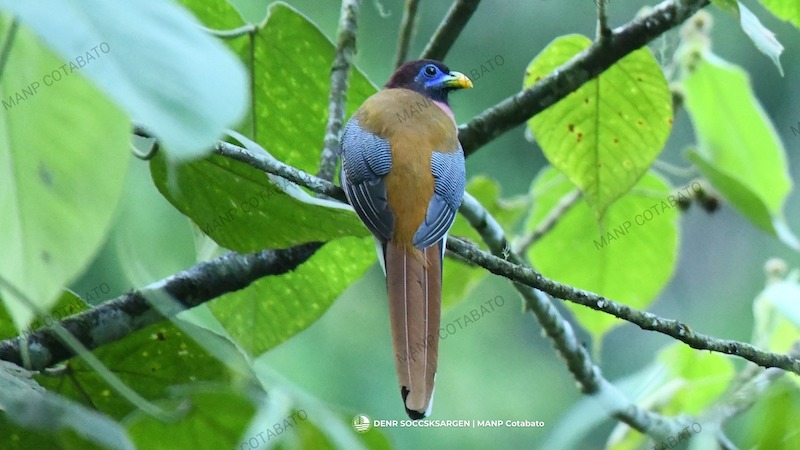GENERAL SANTOS CITY (MindaNews / 05 May) — A rarely seen bird species, fondly referred to by avian enthusiasts as the mythical Ibong Adarna, and other wildlife were spotted by biodiversity monitors who were checking on the effects of El Nino in forests around Mount Apo, the country’s highest peak.
A report by the Department of Environment and Natural Resources (DENR) in the Soccsksargen region said at least four Philippine Trogons (Harpactes ardens), a Philippine Pygmy Squirrel (Exilisciurus concinnus) and a Mindanao Tree Squirrel (Sundasciurus mindanensis) were sighted and documented from April 22 to 27, this year.
 At least four Philippine Trogons (Harpactes ardens), were sighted and documented from April 22 to 27 in Mt. Apo Natural Park. Photo courtesy of DENR Soccsksargen-MANP Cotabato
At least four Philippine Trogons (Harpactes ardens), were sighted and documented from April 22 to 27 in Mt. Apo Natural Park. Photo courtesy of DENR Soccsksargen-MANP Cotabato
A week-long monitoring at the Mt. Apo Natural Park (MANP) confirmed the presence of the wildlife species inside the 80,864-hectare Mount Apo Natural Park (MANP). The park has been closed to the public as a precaution to wildfire during El Nino-induced dry spell.
The monitoring mission was to look into MANP’s forest ecosystems and see if it still has active ecological processes. It also sought to check on the effects of the prolonged dry spell to wildlife, DENR Soccsksargen executive director Felix Alicer told a press conference here on May 4.
He said a close monitoring of MANP provides significant insight into the present condition of the park’s ecosystems and wildlife as it helps guide conservation efforts in habitat preferences and population trends of the various species in the park.
“Mythical bird” sighting
The chance encounter with the colorful Philippine Trogon was the second since last year at the sprawling natural park that straddles portions of towns along the boundaries of Cotabato-Davao del Sur provinces, Alicer said.
The Philippine Trogon with its colorful feathers was associated by bird lovers to the fictional Ibong Adarna.
Trogons are revered by the Obu Manuvu, an animist indigenous people that inhabits the highland fringes of Cotabato, Bukidnon and Davao del Sur provinces.
They call the bird Arak, a symbol of their heritage which is linked to land and its environment, said Renny Boy Takyawan, an IP heritage advocate.
The “Arak” is the sole species of trogon that is endemic to the Philippines, a DENR briefer said.
Conservation efforts are guided by the ongoing monitoring of the trogon’s habitat preferences and population trends, providing significant insight into the present condition of the MANP’s ecosystems.
Endemic squirrels
The monitoring teams found and documented for the first time the Mindanao Tree Squirrel (Sundasciurus mindanensis), of the rodent family and endemic to Mindanao. It was the second sighting of the Philippine Pygmy Squirrel (Exilisciurus concinnus) since last year.
The existence of these two squirrels at MANP indicates that the park can sustain a variety of wildlife populations and points to useful conservation management practices in the area.
Like the Trogons, the two Philippine endemic squirrel species were listed as least concern species by the IUCN. Their presence in MANP, however, serves “a crucial reminder for people to preserve and safeguard the biodiversity and general well-being of the park,” the MANP monitoring report said.
Alicer said the existence of the rare bird and squirrel species is an indicator of overall ecosystem health of the natural park. Their sensitivity to habitat disturbances and environmental changes makes them valuable bioindicators, he said.
In March 2016, bush fires that burned day and night for almost two weeks razed more than 100 hectares of forest, prompting the government to shut the park from the public for about a year. (Rommel G. Rebollido / MindaNews)
